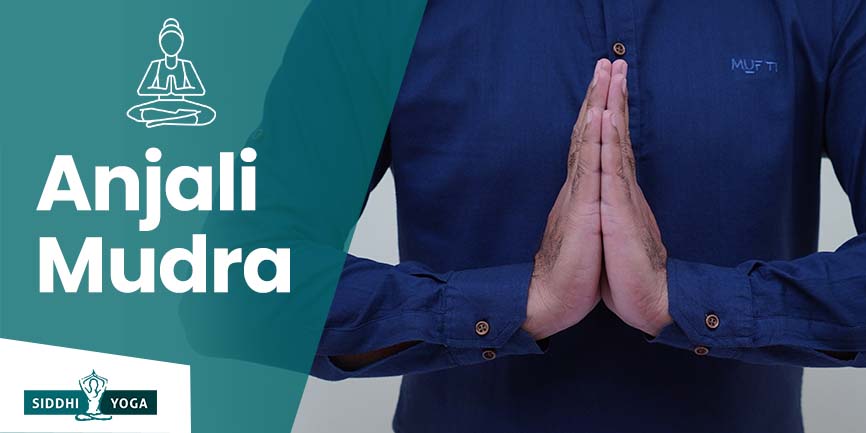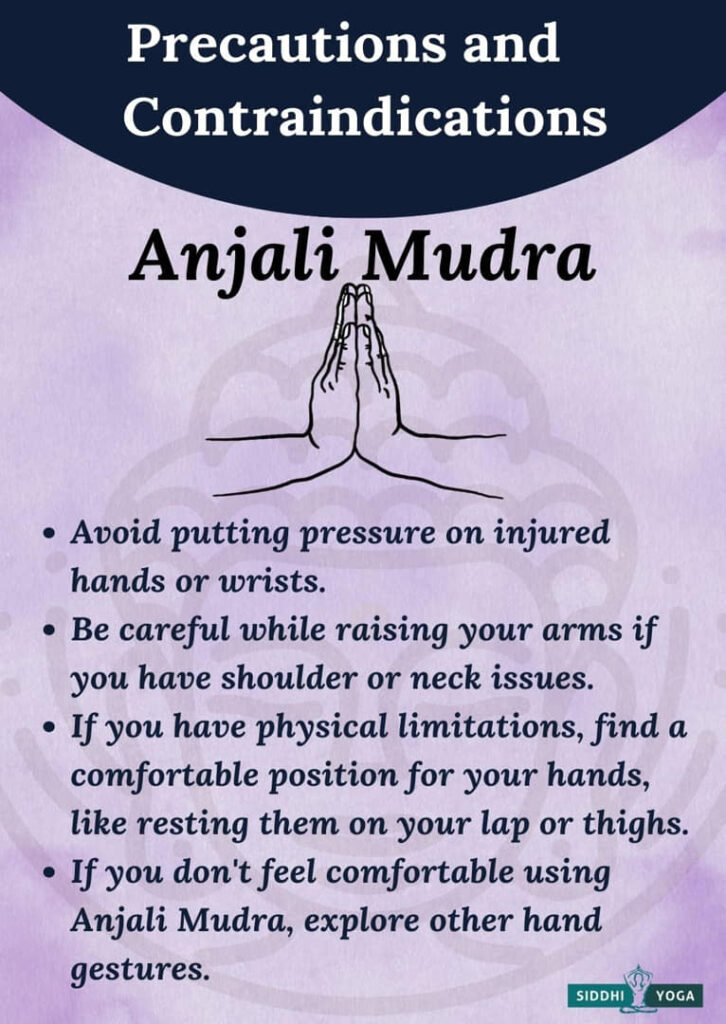
The Anjali Mudra is a simple yoga pose with many benefits. Learn how to do the Anjali Mudra in this guide and discover its meaning.
Definition – What is Anjali Mudra and its Meaning, References, and Mythology?
Anjali Mudra Mudra is often called Namaskar Mudra/ Namaste Mudra because this Mudra is generally followed by Namaskar/ Namaste, which is a form of greeting in India. The Mudra itself is called Anjali Mudra. And Namaskar is made of two words, the literal meaning of which is:
Naman/Namas – Bowing & Kara – Work.
Yoga sessions mostly start and end with this Mudra only.
Even when you feel low, you will experience that it is human’s natural tendency to pray in this Mudra. Your arms will naturally come close to your mouth, to your nose, or close to your heart center.
Our brain is made up of two hemispheres, the left hemisphere and the right hemisphere. When we join our palms together in Anjali Mudra, it represents the balance between the two hemispheres. It also promotes a better smooth connection between both hemispheres.
Anjali Mudra makes us more humble and down to earth. It teaches us harmony.
Coexistence is the right way forward. A world where you coexist with nature, the tree, the birds & the animals. Humans are destroying everything for the sake of their development. But this development comes with a cost. By practicing this Mudra, we can better understand coexistence and how we can harmonize with the external and internal worlds. Practicing this brings calmness, silence & peace.
Practicing this Mudra while meditating can make you more devoted to your practice. So, it is very helpful for those new to meditation who find it difficult while maintaining concentration.
When this Mudra is used as a greeting, it often means – I bow the divinity within you from the divinity within me.
Anjali Mudra is also a part of various dance forms. Many Southeast Asian countries practice this Mudra as well.
Anjali word, which arises through Sanskrit, means the cavity formed when we join the palms together.
Alternate Names of Anjali Mudra
Namaskar Mudra/ Namaste Mudra.
How to Do Anjali Mudra?
- You can perform this Mudra in various postures if you feel comfortable doing so.
- However, to achieve its maximum benefits, it is recommended that you practice it while sitting in any comfortable seated (meditative) posture. Try to choose postures in which you can distribute your entire body weight equally. And initially, keep your hands comfortably placed on your knees.
- Now Keep your neck and spine comfortably erect.
- Gently close your eyes.
- Bring your entire awareness towards the breath. Breathe deeper and longer.
- Slowly and gently, bring your hands close to the heart center.
- And join the palms together such that a little cavity should remain there.
- All the fingertips & thumbs comfortably touch each other.
- Your thumbs are slightly resting on your sternum (breastbone).
Also See: Online Yoga Teacher Training
Anjali Mudra Benefits

- Better connection between two hemispheres of the brain: to experience this, start with sitting or standing in a posture where you can divide your entire body weight into two halves (e.g., Lotus Pose, Auspicious Pose & Mountain Pose). Now, gently close your eyes. And bring your palms together close to the heart center (or chest center). After a while, you will observe the subtle changes, the calmness.
- It increases focus, and by practicing this, you can achieve great concentration, which is ideal for practicing pranayama and meditation.
- Those who are seeking spirituality can get immense benefits from it. It makes us more humble and down-to-earth.
- Makes a person calm, kind, playful, and active.
- It helps to develop a personality that everyone admires.
- It improves awareness and promotes mindfulness.
Anjali Mudra Precautions and Contraindications

Similar to all other Mudra practices, it has no side effects.
However, there are a few things to consider:
- Do not firmly press your finger against each other. They should be slightly touching each other and not put excessive pressure.
- A small cavity should remain there when we join the palms together.
- Keep your spine comfortably erect.
When and how long to do Anjali Mudra?
This Mudra can be practiced in a lot of different ways, such as:
- To show gratitude.
- To greet someone.
- To request.
- To worship or pray.
This Mudra can be practiced whenever you feel you are lacking focus.
Morning is the ideal time to do any yoga or Mudra. Our brain is at its best in the morning and during the daytime. So, you are more likely to be able to concentrate easily. Therefore, you should practice this Mudra from 4 am and 6 am to get the most effective outcomes.
If you are having difficulty with this during the morning, you can do this Mudra later in the evening too.
Practicing this Mudra for a minimum of 30-40 minutes daily is recommended. Whether you wish to complete it in one stretch or two threes that last between 10 and 15 minutes, it’s up to you. Based on research, the best way to practice an exercise for at least 20 minutes is to get the best benefits of that particular Mudra.
Breathing in Anjali Mudra
There are three types of breathing we can practice with this Mudra:
- Abdominal Breathing.
- Thoracic Breathing.
- Yogic Breathing (Abdominal Breathing, Thoracic Breathing & Clavicle breathing.)
Visualization in Anjali Mudra
- Visualize that divine energy within you is radiating rays of blue color.
- Your entire body is experiencing this blue light.
- Wherever this ray falls, it heals.
- Your entire body feels light, and your mind has become still.
Affirmation in Anjali Mudra
While practicing this, Keep a positive intention. Start with:
“I have divine powers. I am here to learn about my existence and to liberate myself from sufferings.”
Conclusion
The Anjali Mudra is a Mudra, or gesture, associated with prayer and meditation. The literal translation of Anjali is “offering,” which refers to the offering of the palms in front of the heart chakra. The Mudra can be done seated or standing, and it is commonly used in yoga to ground oneself before beginning a practice. There are many benefits to practicing the Anjali Mudra, including promoting peace and calmness, increasing focus and concentration, opening the heart chakra, and providing relief from anxiety and stress. If you’re interested in learning more about Mudras and how to use them in your own life, check out our Mudras Certification Course. In this course, you’ll learn all 108 Mudras, their benefits, and how to incorporate them into your daily practice.